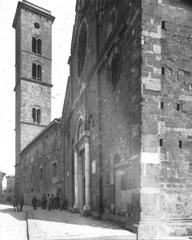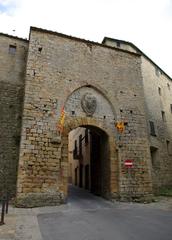Porta San Felice Visiting Hours, Tickets, and Historical Guide: Volterra, Italy
Date: 14/06/2025
Introduction
Porta San Felice, set within the historic walls of Volterra, Tuscany, is a striking example of the city’s enduring medieval architecture and layered heritage. Constructed in the 13th century as part of Volterra’s expanded fortifications, this gateway not only served a defensive purpose but also evolved into a symbolic and practical threshold connecting the city to the Tuscan countryside. Its proximity to the Fonte di San Felice—a vital water source for locals and travelers—highlights the thoughtful urban planning of the period. Today, Porta San Felice is open year-round at no cost, offering visitors a unique portal into Volterra’s storied past and panoramic views of the Val di Cecina.
This comprehensive guide provides insights into Porta San Felice’s history, architectural features, visiting hours, ticketing, accessibility, travel tips, and nearby attractions. Drawing on authoritative sources such as Visit Tuscany, Wanderlog, and Toscana Oggi, it is designed to enrich your experience, whether you are a history enthusiast, cultural traveler, or casual visitor.
Table of Contents
- Origins and Medieval Construction
- Evolution Through the Renaissance and Beyond
- Urban Role and Historical Significance
- Architectural Features
- Preservation and Modern Context
- Visiting Hours and Ticket Information
- Travel Tips and Accessibility
- What to See and Do
- Nearby Attractions
- Events and Tours
- Practical Visitor Information
- Frequently Asked Questions (FAQ)
- Conclusion
- References
Origins and Medieval Construction
Porta San Felice was erected in the 13th century during a period of heightened urban fortification. Volterra, like many Tuscan hill towns, faced threats from rival city-states, notably Florence and Pisa, prompting the construction of robust defensive walls and controlled entry points. Porta San Felice’s arched stone passageway and flanking towers are representative of medieval military engineering, designed to monitor and secure the southwestern approach to the city (Wanderlog).
The gate’s strategic location provided both protection and access, especially to areas crucial for trade and agriculture. Its immediate proximity to the Fonte di San Felice, a communal fountain, underscores the dual focus on defense and daily urban life.
Evolution Through the Renaissance and Beyond
Over the centuries, Porta San Felice’s function shifted from military defense to a civic and symbolic role. While it continued to serve as a regulated entry point, the relative peace of the Renaissance era saw its defensive features maintained but less frequently adapted. Unlike other city gates, Porta San Felice largely retained its medieval character, with only minor modifications to accommodate changing technologies and needs (Visit Tuscany).
Urban Role and Historical Significance
The gate played a critical role in Volterra’s urban development. It marked the start of a main thoroughfare into the city, guiding the movement of people and goods. The adjacent Fonte di San Felice was not only a vital water source but also a social gathering place, reinforcing the gate’s significance as a focal point in city life (Wanderlog).
Porta San Felice also witnessed key historical events, including sieges and conflicts, such as the 15th-century Florentine assault. Its defenders contributed to maintaining Volterra’s autonomy, and the gate’s survival through these episodes attests to the quality of its original construction (Visit Tuscany).
Architectural Features
Porta San Felice is distinguished by its robust medieval stonework—an arched entrance flanked by defensive towers and remnants of battlements and arrow slits. These features reflect both the military and practical needs of the era. The adjacent Fonte di San Felice, a stone fountain, is integral to the site, highlighting the interplay between utility and defense (Visit Tuscany).
Nearby, the Oratorio di San Felice, built in 1701, contains a Baroque tondo painting by Giuseppe Arrighi. The combination of gate, fountain, and oratory creates a harmonious architectural ensemble.
Preservation and Modern Context
Preservation efforts in the 20th and 21st centuries have focused on maintaining Porta San Felice’s structural integrity while conserving its historic character. The gate is now an open, accessible monument, with informational signage and, occasionally, guided tours. Restoration campaigns have also addressed challenges posed by time and environmental factors, ensuring the site remains safe and engaging for visitors (Wanderlog).
Visiting Hours and Ticket Information
- Visiting Hours: Porta San Felice is accessible year-round, with no formal opening or closing hours. It is best visited during daylight for safety and optimal views.
- Tickets: No entrance fee is required. Guided tours, which may include Porta San Felice as part of a broader itinerary, may charge a fee and require booking (Visit Tuscany).
Travel Tips and Accessibility
- Footwear: Wear comfortable shoes; the terrain is uneven and cobbled.
- Best Time to Visit: Spring and autumn offer mild weather and fewer crowds.
- Accessibility: Pathways and the gate itself may be challenging for visitors with mobility impairments, as there are no dedicated ramps or handrails.
- Photography: Permitted and recommended—Porta San Felice is particularly photogenic at sunset or in soft morning light (Evendo).
What to See and Do
- The Gate: Explore its original medieval features and enjoy the structure’s authentic atmosphere.
- Fonte di San Felice: Adjacent to the gate, this historic fountain is a peaceful spot and an example of medieval urban infrastructure.
- Oratorio della Madonna del Gabellino: Located just north, this small chapel, built in 1707, features works by Giuseppe Arrighi and Ippolito Cigna (Wikipedia).
- Panoramic Views: The gate offers sweeping vistas over the Tuscan countryside, ideal for photographers and nature lovers.
Nearby Attractions
- Piazza dei Priori: The city’s main square, home to Tuscany’s oldest town hall (Italy’s Dream Tourism).
- Roman Theatre: Notable archaeological site near Porta Fiorentina.
- Duomo di Volterra: The city’s cathedral, featuring medieval art and architecture.
- Ecomuseo dell’Alabastro: Museum dedicated to Volterra’s alabaster tradition.
Events and Tours
Porta San Felice is included in many walking tours of Volterra’s historic center. Check with the tourist office in Piazza dei Priori for current offerings, including the Volterra Card, which grants access to multiple attractions (My Travel in Tuscany). Occasionally, cultural events and local festivals feature processions passing through the gate.
Practical Visitor Information
Getting There
- By Car: Park outside the city walls (ZTL restrictions apply); walk to Porta San Felice from public lots (My Travel in Tuscany).
- By Public Transport: Take a bus from Pontedera or Saline di Volterra; the gate is within walking distance from Volterra’s main bus stop.
- On Foot: Easily reachable from the city center along well-marked routes (Evendo).
Amenities
- Local Shops and Cafés: Artisan shops and cafés nearby offer refreshments and souvenirs.
- Tourist Office: Located in Piazza dei Priori, provides maps, information, and the Volterra Card.
- Emergency Services: Dial 112 for emergencies.
Frequently Asked Questions (FAQ)
Q: What are the visiting hours?
A: Porta San Felice is accessible at any time; best visited during daylight.
Q: Is there an entrance fee?
A: No, visiting the gate and adjacent fountain is free.
Q: Are guided tours available?
A: Yes, many walking tours include Porta San Felice; check with local operators.
Q: Is the site wheelchair accessible?
A: Accessibility is limited; uneven terrain and lack of modern ramps.
Q: Where can I park?
A: Use public parking outside the city walls to avoid ZTL fines.
Q: What’s the best time for photos?
A: Early morning or late afternoon for optimal light and fewer visitors.
Conclusion
Porta San Felice is a living testament to Volterra’s resilience, architectural ingenuity, and community spirit. From its origins as a fortified gateway to its present-day role as a cherished monument, it encapsulates centuries of history—Etruscan, medieval, Renaissance, and beyond. Visitors today can enjoy its well-preserved structure, scenic views, and the vibrant neighborhood that surrounds it. With no entrance fee, year-round access, and rich historical context, Porta San Felice is an essential destination for anyone exploring Volterra. Enhance your visit by joining a guided tour, attending local events, or using resources like the Audiala app for immersive experiences. For up-to-date information, consult Visit Tuscany and Move About Italy.
References
- Visiting Porta San Felice: Hours, Tickets, History, and Travel Tips for Volterra’s Historic Gateway, 2025, Wanderlog
- Architectural Features and Visiting Information for Porta San Felice, 2025, Visit Tuscany
- Porta San Felice Visiting Hours, Tickets & Volterra Historical Sites: A Complete Guide for Visitors, 2025, Toscana Oggi
- Porta San Felice Visiting Hours, Tickets, and Travel Guide to Volterra Historical Sites, 2025, My Travel in Tuscany
- Move About Italy: Volterra Gates, 2025
- World Heritage Site: Volterra Tentative List, 2025
- Evendo: Medieval Gate and Fountain of St. Felice
- Italy’s Dream Tourism: What to Do in Volterra
- Wikipedia: Oratorio della Madonna del Gabellino, Volterra

